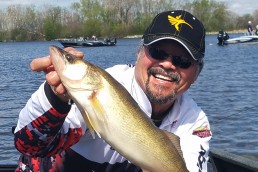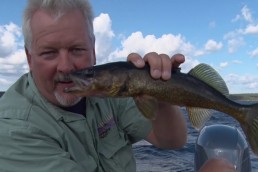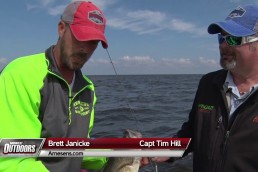Fishing Walleyes in Heavy Cover
SHARE THIS POST
There’s not much that slips by us when it comes to fishing with slip-bobber rigs. Slip-bobbers work well when targeting walleyes and other fish within heavy cover, such as wood or weeds all across the country.
Slip-bobbers are effective all summer and even work well during the winter months. Fish often hold close to cover throughout the year. The key is the right rig, in the right place, at the right time.
Start with 10-pound super braid, packed onto a spinning reel, matched with a 7-foot, 6-inch St. Croix rod. The extra length within the longer rod helps take up slack during a hook set. Then, add a thread-style bobber stop.
Next, thread on a slip bobber and tie a small barrel swivel, which stops the bobber from sliding down. Then, from the swivel, tie on a 2-foot leader of 8-pound monofilament line. Rigged this way, if you get snagged and must break off, you only lose what’s below the swivel instead of losing the entire rig, float and all. Lastly, tie on a plain hook, a small 1/32 oz. jig, or a weedless-style jig. Experiment with style and color.
Add enough weight to balance the float, hook on a leech, and you’re set. Split shot will do. But, consider using a rubber-core sinker to avoid pinching and weakening the line. A 1/8-ounce, rubber-core sinker works well with most floats.
Targeting walleyes in the woods
Concentrate on the shallow wood, just 3 to 5 feet deep, early in the summer. Try moving deeper, to the 12- to 14-foot-range, by late July and early August. Wetter than normal years with high water will often keep walleyes in shallow water for longer.
Trees with branches that spread out will often work much better than ones that are just straight up and down. The bigger fish are in the thickest trees and the heavier the concentration of trees, the better. Eliminate unproductive areas by looking for points and inside turns in the treeline.
Tie both the front and rear of the boat to the trees above the water, if you can. That eliminates lost anchors as well as needless boat movement that causes bobbers to drift and may cause snags.
Are you enjoying this post?
You can be among the first to get the latest info on where to go, what to use and how to use it!
Try fishing a jig without a float, straight up and down over the side of the boat, for more-vertical hooksets. Casting too far away from the boat will lead to hang-ups.
The normal rule-of-thumb when it comes to walleye fishing is – wind and waves are best. But, when slip-bobber fishing wood, calm water is the best time to fish. In rough water, the tree branches move about and scare out baitfish and the walleyes. Rough water also makes snags more likely. If it gets too rough, try trolling crankbaits or bottom bouncer/spinners outside the trees or weedline.
Mind your depth, set bait near the bottom
Set your bobber stop so that the bait rides about a foot off bottom. In thick cover, set the bait two feet up so the leech can’t swim into the branches and hang up. A higher setting also gives you more time to set the hook before a walleye grabs the bait, swims back into the wood and gets snagged.
For the same reason, set the hook fast to avoid trouble. Don’t be afraid to horse the fish up.
You can use slip-bobbers to target vegetation, too. There are a lot of fish in the weeds. Again, eliminate wasted time by focusing on the points and inside turns in the weed-line.
Great places to try are pockets in the weed bed, especially larger clearings surrounded by vegetation where walleyes can lay in ambush. You should give prime areas like those up to a half hour to produce. When you decide to move, move only a short distance: maybe 20 yards or so.
The time of day doesn’t seem to be a factor in how well wood and weeds produce. They can be active all throughout the day since the shade of the cover helps make the fish feel more secure.
Try slip-bobbers in heavy cover in summer. Don’t let walleyes give you the slip.
MWO
SHARE THIS POST
Did you enjoy this post?
You can be among the first to get the latest info on where to go, what to use and how to use it!
Ted Takasaki
Ted Takasaki is an International Fishing Hall of Fame professional angler who has been featured in many national outdoor magazines and television shows. Takasaki has appeared in front of thousands of angling enthusiasts and is considered one of America’s top walleye and multispecies anglers. Follow him on his Facebook page.



